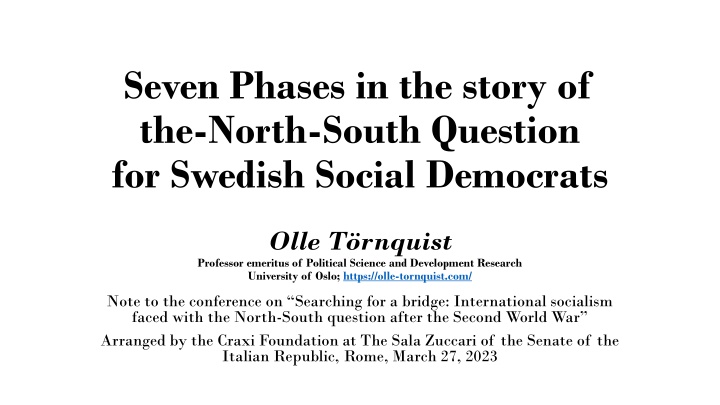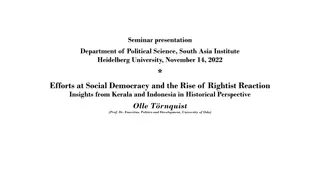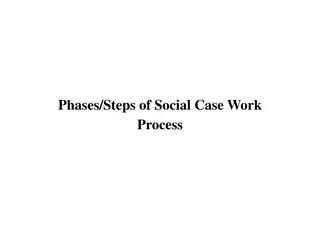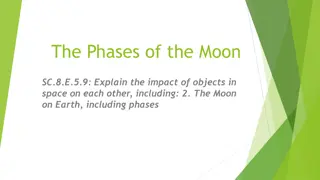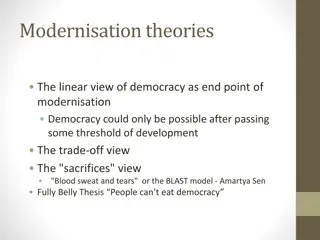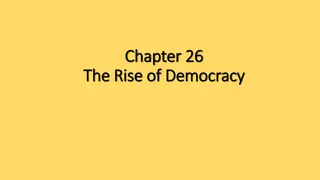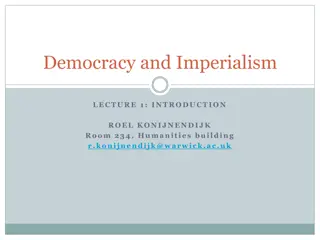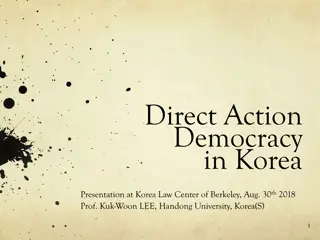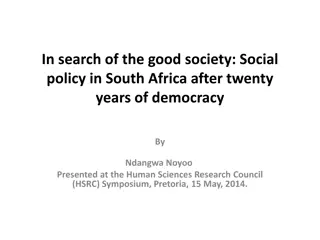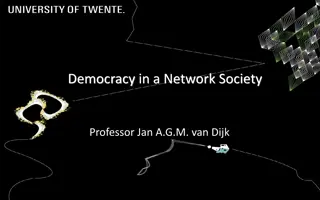Phases of the North-South Question and Social Democracy Evolution
Explore the evolution of Social Democracy in relation to the North-South question through seven phases outlined by Olle Törnquist. The discussion spans from the 1930s to modern times, highlighting shifts in international cooperation, economic ideologies, and political conditions that have influenced the progression of Social Democracy both within nations and across borders.
Download Presentation

Please find below an Image/Link to download the presentation.
The content on the website is provided AS IS for your information and personal use only. It may not be sold, licensed, or shared on other websites without obtaining consent from the author.If you encounter any issues during the download, it is possible that the publisher has removed the file from their server.
You are allowed to download the files provided on this website for personal or commercial use, subject to the condition that they are used lawfully. All files are the property of their respective owners.
The content on the website is provided AS IS for your information and personal use only. It may not be sold, licensed, or shared on other websites without obtaining consent from the author.
E N D
Presentation Transcript
Seven Phases in the story of the-North-South Question for Swedish Social Democrats Olle T rnquist Professor emeritus of Political Science and Development Research University of Oslo; https://olle-tornquist.com/ Note to the conference on Searching for a bridge: International socialism faced with the North-South question after the Second World War Arranged by the Craxi Foundation at The Sala Zuccari of the Senate of the Italian Republic, Rome, March 27, 2023
Point of departure: whats the relevance of the South in fostering Social Democracy in the North? What version of Social Democracy (beyond party labels)? There are four universal dimensions: (i) interest based collectivities, (ii) democracy, (iii) welfare, and thus based (iv) social (and sustainable) growth pacts. But what about: (i) taming or transforming capitalism? (ii) nation-centrism or international? During what political and socio-economic conditions? (i) World economic crisis (1930 s) and 2ndWorld War (ii) Post World War cooperation (E.g. Bretton Woods; Marshall aid) (iii) Anti-colonialism, with a second wave of democracy (iv) Cold War (v) Neo-liberal globalisation and third wave of democracy (vi) Refugee crisis (vi) Rise of authoritarian nationalism and new Cold War
First phase 1930s - 1950s Nation-centrism South irrelevant Aim: Transformative & nationally confined Social Democracy ( people s home /welfare & social pacts with capital and farmers) In addition to the four basic social democratic dimensions, also: (i) fundamental support of free trade to enable export, and (ii) not just support for labourers but also farmers. No colonial engagements. Neutrality and non-alignment, but later on post-war cooperation with the West (Bretton Woods etc.)
Second phase 1950s - 1970s Nationalist-internationalism Sustained non-alignment and efforts at transformative nationally confined Social Democracy But new post war conditions of anti-colonial second wave of democracy, big-power-domination and Cold War. This called for similar kind of internationally oriented and non-nativist nationalism as in the anti-colonial democratic movements. Therefore focus on pro-international cooperation including in the South and with UN, the non-aligned movement and support for likeminded actors in the South also with generally social democratic oriented liberation movements. This intensified from the 1960s under Olof Palme. But over the years, the pro-democratic movements in the South were weakened and Cold War-nourished-authoritarian-rulers gained strength.
Third phase 1970s mid-1980s North South Partnership New conditions with weakened partners in the South & internationalisation of capital: global neo-liberalism, authoritarian export-driven development states, OPEC oil-price hike without similarly increased demand for northern products. This undermined nationally confined Social Democracy in e.g. Sweden. Thus efforts to counter this by internationalising social democratic Keynesianism with New International Economic Order (NIEO) and North South Partnership . Including for Sustainable Development. Simultaneously, moreover: the rise of the third wave of democracy. So the NIEO-efforts were combined with Common Security, Human Rights, Gender Equality and Democratisation. Driven by Willy Brandt, Olof Palme et al. Including through the Socialist International, but also with other like-minded democratic leftists.
Fourth phase Mid-1980s 2010s Structural adjustment & 3rdwave of democracy New conditions with the failure of NIEO and North-South Partnership, and the dominance of neo-liberal globalisation along with authoritarian development states. Hence even more difficult to push for transformative nationally confined Social Democracy in countries like Sweden. While the Swedish non-alignment was formally sustained, the aim shifted, therefore, to the taming rather than transformation of capitalism, with Blairs , Clinton s & Schr der s third way policies. The main international focus turned structural adjustment to liberal globalisation. By implication, social democratic development in the South was not vital anymore. Still, elite-negotiated democracy, human rights and especially good governance remained priorities.
Fifth phase Mid-2012 2015 Efforts to resume nationalist-internationalism New conditions: (i) Financial crisis, (ii) rise of right-wing-led nationalist reaction against the drawbacks of the third road , (iii) leftist quests for the resuming of transformative Social Democracy. New party leader, trade unionist Stefan L fven, tried to resume welfare-based social growth pacts along with less unfair globalisation through a Global Deal for multi-stakeholder social dialogues and inclusive growth . Plus along with greens and leftists support for sustainability and intensified international solidarity, including with refugees, and a feminist foreign policy.
Sixth phase Late-2015 2022 Return to nation-centrism South deprioritised New conditions: (i) Refugee crisis (due to US-led war against terror and poor support for the Arab Spring); (ii) strengthened right- wing-led nationalist counter movement. Thus, defensive return to the nationalist-sovereignty priorities of the first phase (1930s-1950s), along with nativist social welfare priorities. Friendly critics also ask return to transformative social democratic agenda, to counter the right wing nationalism but the critics do not ask for the return to international engagement (incl. with the South) to enable such national priorities.
Seventh phase Spring 2022 Adjustment to New Cold War vs. a Third Position New conditions: Russian war on Ukraine and US-led NATO- and EU- coalition in defence of the post Cold War liberal order. Mainstream social democratic response: Scrapping non-alignment and other remnants of Palme s internationalism in favour of not just coordination in EU and with NATO but also by joining NATO. Dissenting third position: Do counter Russia s aggression! (Just as US historical interventions.) But focus on the main enemy: global authoritarian nationalism. And on the causes for it: the incapacity of the elitist third wave of democracy to counter the negative effects of global neo-liberalism. In Yeltsin s & Putin s Russia as well as in the South. This calls for a broad alliance (incl. self-critical liberal democrats) for more democracy and social democratic oriented international development.
